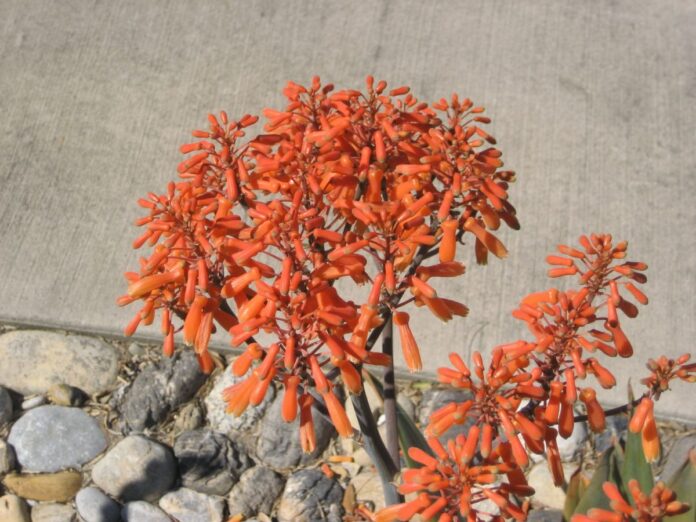BY GARY SMITH
The famous Aloe vera plant has been grown around the world for its rejuvenating, healing, or soothing properties. Aloe vera is commercially cultivation right here in the RGV and thrives in our dry subtropical environment. In fact, it was one of the few plants around the house I bought during the 2011 drought that had survived for months (?years?) without added water. However, its survival skills come as a mixed blessing in an ornamental garden. Wherever planted, Aloe vera sends out suckers which form dense, expanding colonies that few herbivores or herbicides can control. It flowers frequently on spikes but the blooms are usually sparse and fall off quickly in flower arrangements.
But other members of the genus Aloe, mostly from southern Africa, can make spectacular large shrubs or small trees in RGV. Their bold spikes of orange/vermillion flowers brighten the winter landscape (January to March), in the company of Cape Fuschia, Bouganvillea, and Crown-of-Thorns. But don’t be surprised if you share the flowers with our winter pollinator friends. Honey bees buzz merrily and hummingbirds dart in and out of the tubular flowers. Then in February, be ready to share their flower spikes with the equally brilliant oriole birds who may binge on the flowers until the stalks are nearly bare. These plants are truly RGV winter treasures!
Here are three showstopping species with eyepopping winter/spring flower clusters.
Mountain Aloe (Aloe martlothii ): Young plants are easy to underestimate; spine-covered gray/green succulent leaves expand to 3 foot length in an artichoke-like ball before the trunk develops. Do not plant this aloe too close to trafficways as the spines are sturdy and sharp. The single stout trunk will carry a crown of leaves up to at least 12 feet high. The distinctive flower display begins before the trunk develops. In January into February the horizontal branches of long clusters of tubular yellow-orange flowers curling upwards around the branch. The overall inflorescence can reach 5 feet diameter of twisting intertwined flowering branches.
Tree Aloe (Aloe ferox or excelsa): The most commonly-seen Tree Aloe in local nurseries is probably one of these similar species. The grower may be unsure of details, but even young plants have an unmistakeable uplifting chalice shape with a distinct single trunk. Spines are mostly on leaf margins and less prickly than Mountain aloe. The tubular flowers of this species are exceptionally elegant and brilliant with compact columnar racemes of red, orange or yellow.
These “tree aloes“ favor sunny dry to well-drained intermediate conditions. They vary in frost tolerance from 20 to 32 degrees F. They are tolerant of wind and salt spray; however, they can be top-heavy and vulnerable to blowover in soggy clay soil. Suckers are insignificant.
Coral Aloe (Aloe striata): Coral aloe is well-grounded and grows in rosettes to 3 feet wide with little or no trunk. The 20“ blue-gray-green spineless leaves have a narrow pinkish edge that forms a multicolored skirt as it grows. Generous branching brilliant coral pink/orange tubular flower clusters emerge well above the foliage several times through winter. The contrast of large soft blushing pastel leaves with fiery dayglow flowers is very appealing. Suckers are infrequent. Coral Aloe favors sunny to light shade, dry to well-drained intermediate conditions and tolerates temperatures of 25F or lower.
These aloes have great potential for use in RGV gardens on appropriate sites. Plants can be found at street market vendors and diverse nurseries in small numbers, although large growers are developing new varieties that may appear more widely soon.




